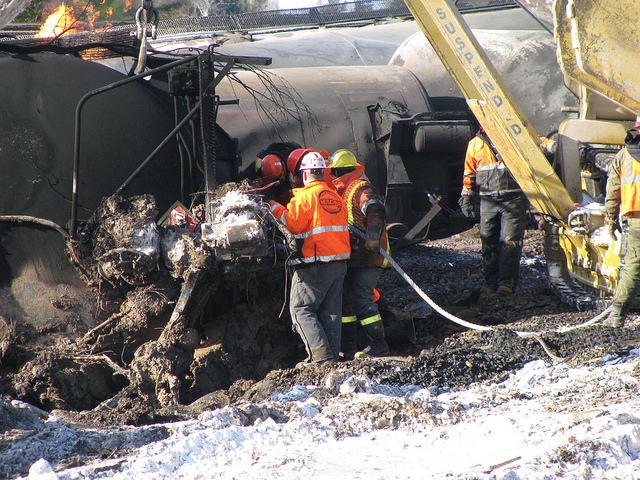WATCH: The Transportation Safety Board has released its final report into a 2014 trail derailment that happened near Plaster Rock. The crash sparked a massive fire and forced 150 people from their home. Global’s Alex Abdelwahab reports.

DIEPPE, N.B. – The Transportation Safety Board says a defective wheel is to blame for the derailment of a CN train in New Brunswick last year.
The board released its findings Friday on the accident near Plaster Rock, N.B. on Jan 7, 2014, where 19 cars and a locomotive jumped the tracks.
The resulting fire forced 150 people from their homes for four days.
TSB Regional Senior Investigator Don Ross told reporters that a wheel on the 13th car shattered because of an area of subsurface porosity that led to fatigue cracking.
The subsurface porosity was not detected during ultrasonic testing when the wheel was manufactured in 1991, nor when it was reprofiled in 2006, the TSB found.
But the results of those tests were not available, Ross said.
“Since 2010, companies conducting ultrasonic tests of wheels are required to keep their results for at least 10 years,” Ross said, adding stricter criteria have also been added to the tests.
The broken wheel and the wheel on the opposite side of the axle derailed, causing track damage for several miles, according to the report.
Ross said crews had been alerted to a problem by a wayside inspection system and were attempting to stop the train when it derailed.
There were three different classes of tank cars among the derailed cars, including two older model Class 111 tank cars that were punctured by the couplers of other cars.
This puncture led to a spill of approximately 230,000 litres of crude oil, fueling a massive fire.
The heat from the fire eventually led to the pressure relief device on two pressurized tank cars to degrade, resulting in the uncontrolled release of liquified petroleum gas, Ross said.
Transport Canada introduced new regulations on May 1 for more robust tank car standards, Ross said, adding the new standard, known as TC-117, will have thicker steel, jacketed thermal protection, full head shields protecting the ends from punctures and improved fitting protection.
“While this is a positive development, the board is concerned with the amount of time it will take to implement these changes,” Ross said.
He said some cars will be able to remain in service until 2025.
The 122-car train was travelling from Toronto to Moncton.
Rail industry has improved communication: Chief
Moncton Fire Chief Eric Arsenault told Global News the rail industry has been improving how they communicate with emergency responders and recent changes now allow first responders to have more information available to them.
“As of just a few weeks ago, there’s a new program in place called ‘Ask Rail,'” Chief Arsenault said.
It allows first responders to have real-time information about a train on their cell phones, giving them the essential information they need to respond to an emergency immediately.
“When we respond to a hazardous material incident, the first priority that we have is to try to find out what are we dealing with,” he said. “We now have the ability to make command decisions much quicker. We don’t have to worry about trying to find people, making several phone calls to get information.”
Chief Arsenault said communities are also being provided with detailed information about the types of hazardous material that will be transported by rail to allow them to plan.





















Comments